This article was first featured in our free weekly Raising Empowered Kids newsletter. Sign up here to receive exclusive first looks at our best strategies, guides; and inspiring stories.
This picture fills me with sadness, yet at the same time, it fills me with hope.
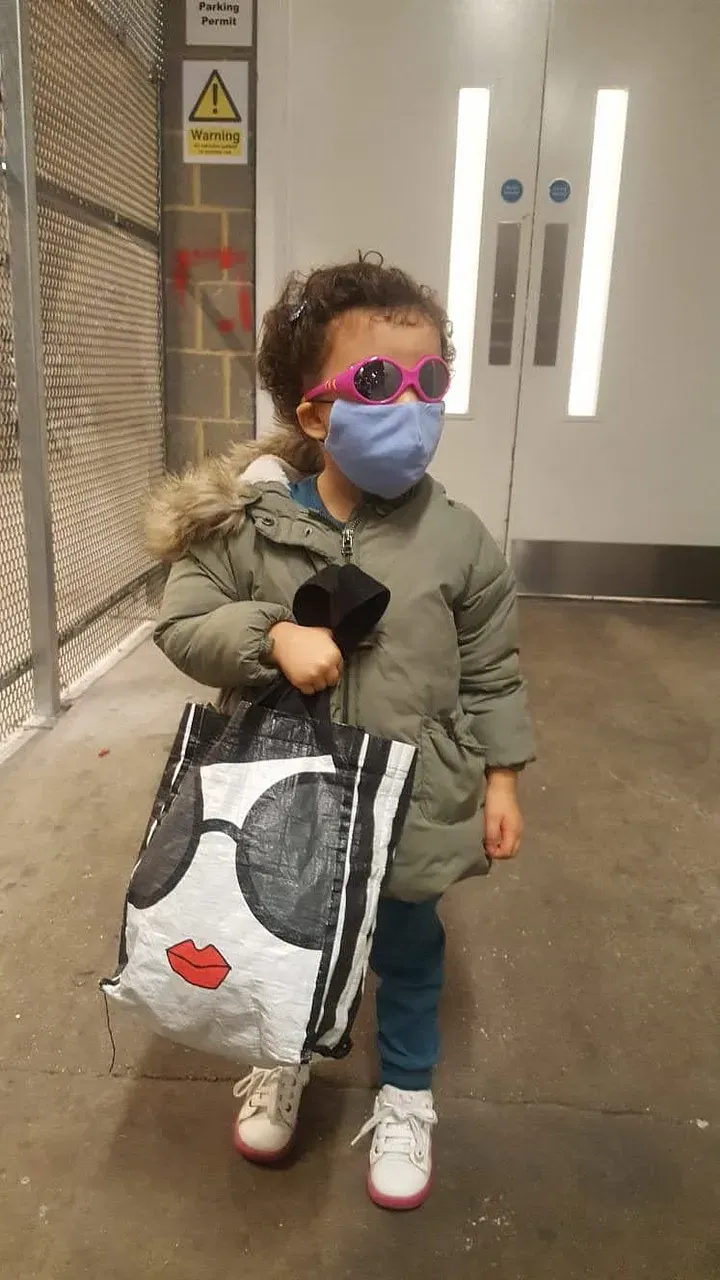
It’s a picture of my then two-year-old, in the middle of the COVID-19 pandemic. She insisted on wearing a mask anytime she left the house and diligently kept it on until she got back home.
It makes me so sad to see pictures from that time. I feel like she, and the children of her generation, were robbed of precious moments in their childhood, when they should have been free to run and play, completely oblivious to the problems of the world.
I also dread to think what else the future will bring as the world becomes even more complex, and even less predictable.
The picture also fills me with hope because, well, she put quite a bit of thought into her outfit, coordinating the bag with her sunglasses. She developed a keen interest in painting during that time too, which she has maintained ever since. It’s the world as she knows it. She understood what was happening during the pandemic, and found her way of adapting to it, and thriving. It reminds me that children are observant, resilient and resourceful.
It also reminds me that the best thing I can do as a parent, is to empower my children to adapt to whatever the world throws at them, and to build the best life they can for themselves. One of the things that they need to do so, is to make sense of what is going on around them and learn how to create positive change.
2 years ago, I decided to embrace a systems thinking perspective, and set out to integrate it in my professional and personal life. As I committed to a short daily systems practice, I started to see systems everywhere and to seek ways to teach some of the concepts to my daughter.
At its simplest level, Systems Thinking teaches us that everything is interconnected and interdependent. This emphasis helps children understand cause and effect, nurtures curiosity, deepens self-discovery, and develops key skills like critical thinking, communication, observation, and analysis. It helps children discover lasting solutions to difficult real-world problems. Willow School, US.
As the school year started, I wanted to share some of the activities that have helped me introduce systems thinking concepts to my daughter, as well as some of the wonderful resources I came across. They are probably most suitable for the 4–7-year age bracket, so they are simple and focus on the concepts in broad terms. Think of them as brushstrokes that set up the colour palette rather than complete paintings.
Have fun!
Zoom in and out
This activity highlights that you can see things very differently when you take a step back and take a holistic view at something.
Before you start the activity, prepare a drawing on a very large piece of paper. With a pencil, sketch a simple landscape like a house with a green space around it, or a sky with clouds, a rainbow, etc. Only use the pencil to sketch the outlines.
Hand your child a set of colourful felt tip pens or markers, and ask them to fill each shape separately using dots created by the markers. Use different colour markers for each shape.

Get them to focus on one shape at a time.
When they finish colouring in all the shapes, change the distance between you and the paper and talk about what you see. Hold the paper very close to their face and draw their attention to the individual dots: what do they look like? How many did they draw? Are they all the same size?
Now step a bit further and talk about the individual shapes formed by the dots. Focus on one shape at a time. Are they made of straight or curved lines? How many sides does the shape have? Were some shapes easier to fill in than others?
Hold the picture even further still and notice the whole image that you created. What is the main thing they notice in the picture? do the dots matter?
Talk about similar situations, e.g. What do you (expect to) see when you walk in a forest vs. when you look at a forest from an aeroplane? What do you notice when you look closely at your mum vs. when you see her working in the garden?
Systems are about relationships
A system is a group of parts or elements that work together to produce a whole. Within this whole, the parts affect each other, and the result is different from the sum of all the parts.
I know, a bit wordy. How to explain that to a child?
Take them to the kitchen. Pick these five ingredients: flour, butter, sugar, eggs, milk.
Now mix the butter and the sugar until they are pale and creamy, add the eggs one at a time and finally fold in the flour [Here’s a simple recipe with quantities]. Pour into moulds and bake in the oven and voilà! You have made some cupcakes.
Take the same five ingredients: flour, butter, sugar, eggs, milk.
This time [link to recipe here], rub the flour and butter until they resemble bread crumbs. Add in a little bit of sugar. Create a well in the middle and pour in the milk. bring everything together into a dough and flatten it with your hands until it’s about 3 cm thick. Now cut circles out of the dough and place them on a baking sheet. Brush with the egg and bake in the oven. Congratulations, you have (hopefully) have made some scones.
Same ingredients, interacting differently with each other, produce different outcomes. This tells you that, although the ingredients themselves are important, the way they work together determines what they produce.
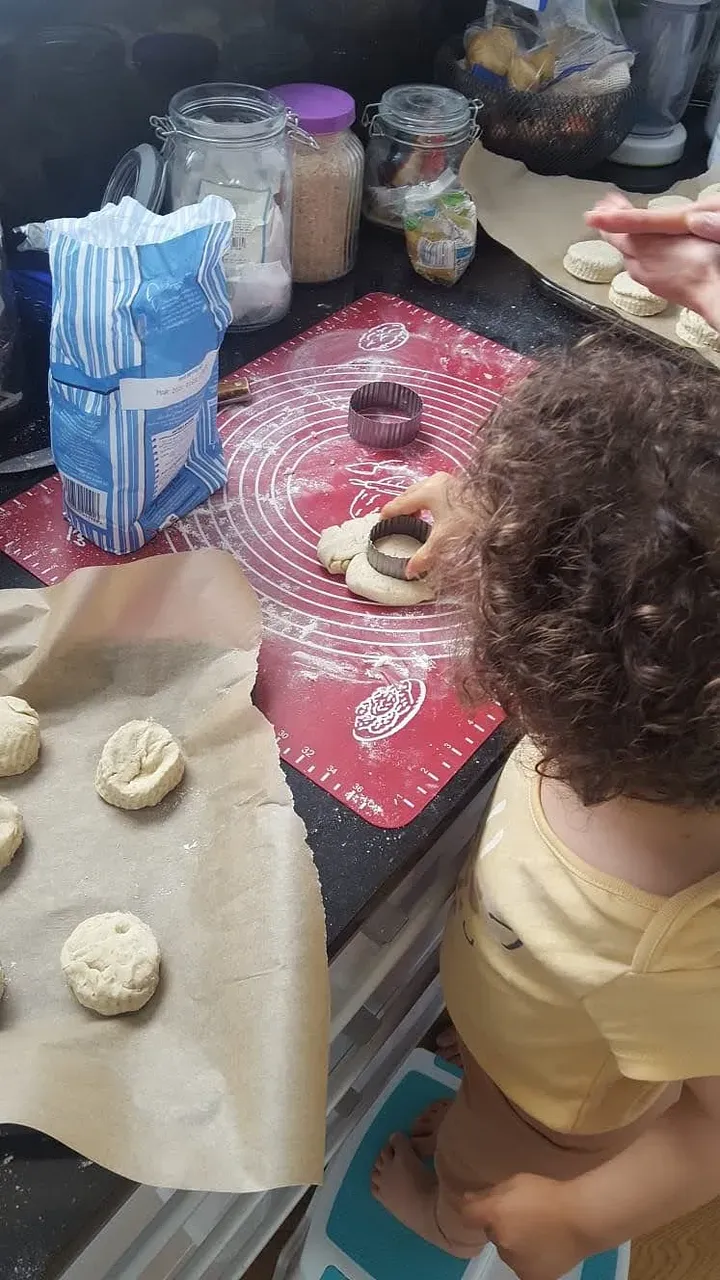
Another thing to talk about is the role of the baker in shaping the final result. The baker determines which recipe they choose, where to buy the ingredients, and how well they mix the ingredients together. Would cupcakes made by Mum look different from cupcakes made by the child? What if a younger/older sibling made them?
The idea here is that the baker is interacting with the ingredients in their own way, and their input also shapes what comes out of the oven. In parallel, the system observer will also shape how they define, observe and design a system.
Now try to find other examples of different parts working together to produce a different outcome. Think of Lego and magnetic tiles, cars, communities, schools, etc.
Embrace multiple perspectives
This activity aims to explain the concept that we all see the world in our own way, and that we need to accept and respect that others also have their own world view.
Pick your favourite children’s story, e.g. Cinderella.
Read (or watch) the story together to ensure that you are all familiar with it.
Write the names of all the characters in the story on small pieces of paper. Write only one name per piece of paper. Put all the names in a box or bag, and take turns to randomly pull a name out.
Once you pull out a character’s name, you have to tell the story through their eyes. To continue with the Cinderella example, you may need to tell the story from the mother in law’s perspective, or that of the sisters, or the prince. Feel free to add in new details but ensure you stay true to the original story.
Talk about the different perspectives. None of them are wrong, they are just different. What would happen if Cinderella and her family sat together and each told their side of the story?
Another way of doing this is role play. My daughter came up with this game, and it’s one of the best ways we found to communicate our feelings and frustrations to each other.
Simply swap roles. You become your child and they become you. See where that takes you. This is as much an activity for the child as it is an activity for you as a parent.
Little gardener
This activity offers so many opportunities to talk about interconnectedness and circularity in nature, systems within systems, change over time and our place as humans within the natural ecosystem.
I’m going to tell you how we've done it, but there are many ways in which you could adapt it based on where you are, what you have available and what your children enjoy.
We started this a couple of years ago, when my daughter was about three years old. I bought her a microgreen kit and we set out to create a little garden. Microgreen seeds sprout very fast, and grow very fast, which helped maintain her interest.
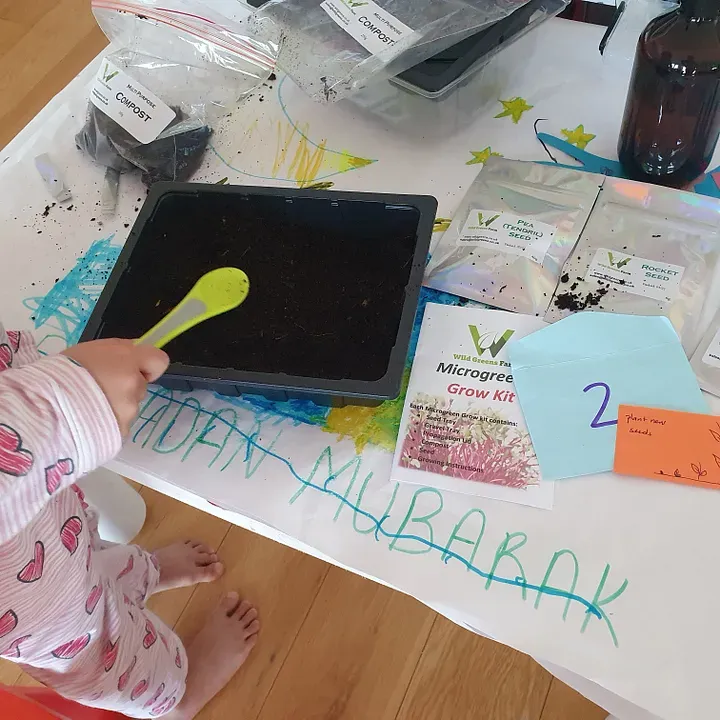
At this point, I must add that the gardening activity is something that evolved organically, and became integrated within our daily life and conversations. It’s not something that I pushed (other than the initial seed planting) with a schedule and a plan. I also never mention the word ‘system’ but use the same language as my daughter.
With each step, we learned about a new system:
1. Preparing the soil
What is in the soil? Food and water to help the seeds grow. Other creatures like worms can eat the soil and poop things that are good for the seeds to turn into plants, and for the plants to grow.
2. Planting the seeds
What is inside the seeds? There is a small packet of instructions (genetic information) and some energy inside a shell that protects it all. When the seeds are in a good place to grow, like the soil we prepared, little shoots and roots break out of the shell. The root grows downwards to drink up the water and food in the soil, and the shoots come up to take in as much light as possible. The light from the sun and nutrients from the ground work together to help the plants grow.
3. Watering the plants
We have to play our part to keep the plants growing, by giving them water. The rain can help, too, but it is a bit unpredictable nowadays (and that’s another story about climate change, for another time).
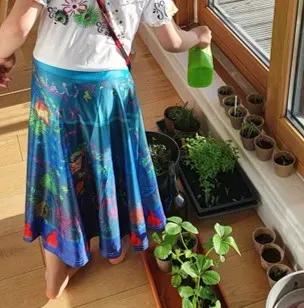
4. Watching the plants grow and flower
It takes time for things to grow and change. Once some of the plants flower (tomatoes and strawberries in our case), a wonderful opportunity arises to talk about bees and cross pollination. By chance, we found ourselves on holiday near the Bee School, which organises bee ‘safaris’ that wonderfully explain the importance of bees for individuals and for the environment.
5. Eating the produce
With much pride, my daughter got to cut some of her plants (micro-coriander and pea shoots) to contribute to a few dinners. She helped make a herby focaccia and tasted her home-grown strawberries (All two of them!!). This was an opportunity to show how she is interacting with the system differently, taking resources from it after feeding and growing it, and how in turn, it was now feeding her.
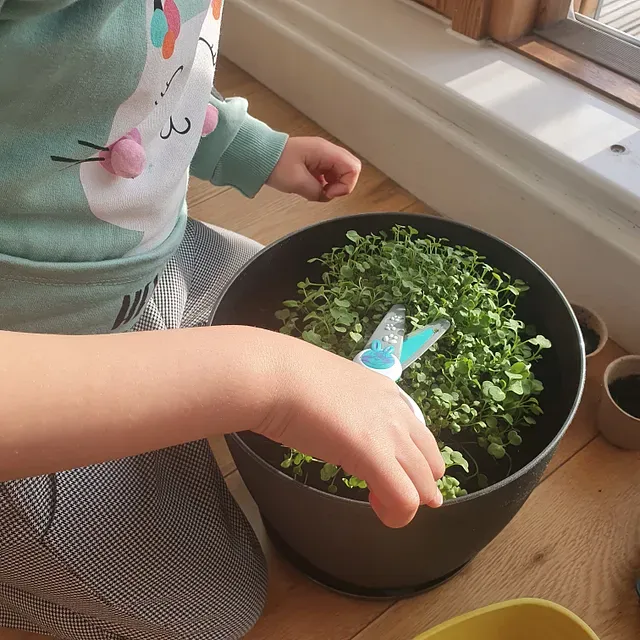
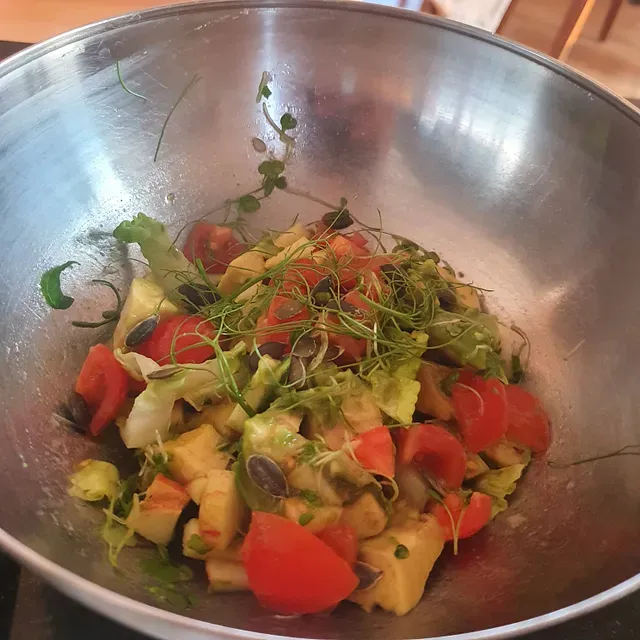
The first time we did this, we harvested all the plants at once, so we had to start again from scratch, replace the soil and plant new seeds.
The second time round, we planted and harvested the seeds in phases, asynchronously, so that we could maintain the ‘supply’ of greens over a longer period of time. With each iteration, we learned something new and tried to apply it in the next round.
6. Coming full circle
This actually came from the school, where the children learned about composting, and how it can be a source of soil. This school activity took us back to square one: the soil and the worms. It was also another example of change that happens over time as it takes quite some time for food waste to turn into soil.
7. Systems within systems
We took advantage of a community initiative near us, whereby volunteers get together every Sunday and take care of the garden. It was a wonderful opportunity to feel part of something bigger and to see that a small activity, like planting a seed, can turn into something bigger, like a community garden, how that can create a space for bees and butterflies, and ladybirds, and squirrels. That in turn becomes a nice place for people to meet and for children to play.
One small change can lead to another, and another, and eventually turn into a bigger change.
Making small changes and correcting actions if needed
This is an exploratory activity that takes advantage of children’s curiosity and play.
It introduces the concept of iteration to produce a desired effect. When we intervene to change a system, we need to observe the consequences of that change on the system, and probably need to tweak again and again to produce the result that we want.
Give your child some flour, water, and some bowls or pots. Let them explore what happens when they mix different things.

Demonstrate how to make a simple dough and ask them to make their own. What happens if they put in too much water? Can they correct it by adding a bit of flour at a time and checking the consistency?
Behaviour over time
This activity was developed by the Waters Centre for Systems Thinking — a wonderful site full of ideas and tools to teach systems thinking. It illustrates a very commonly used tool in systems thinking: the behaviour over time graphs.
Start by watching (or reading) ‘ The Most Magnificent Thing by Ashley Spires (free).

Allow your child to build meaning as they listen to the story. After you watch/read the story, focus discussion on the little girl’s feelings. How angry did she become? What made her angry? Why do you think this made her feel angry? Did she become angrier and angrier?
Use a paper to chart the little girl’s feelings at the beginning, middle and end of the story, with time represented on the X-axis.
Decide with your child what vocabulary to use to represent the little girl’s anger along the Y-axis. My daughter picked ‘not so angry’, ‘medium angry’ and ‘really angry’.
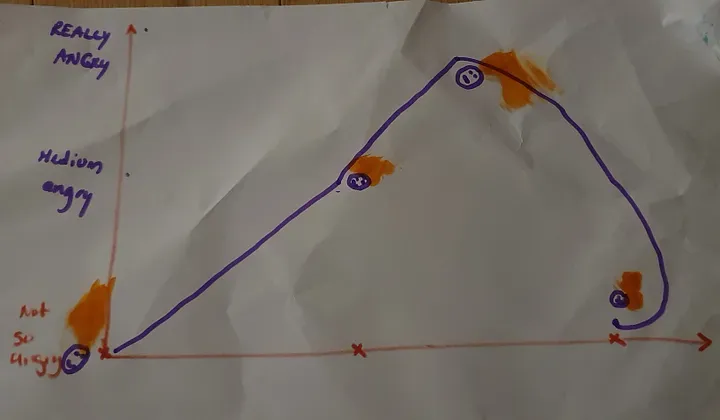
Help your child draw the graph (you might have to do it a few times before they grasp the concept of a chart) then discuss: How did the little girl’s feelings change? How did the line change? Encourage them to use the vocabulary you selected for the behaviour.
Turn the conversation to your child: Has anyone ever made you feel angry? How did you handle your feelings? What can we do if someone makes us feel angry? What should we not do if someone makes us feel angry?
The happiness bank
This is an activity that my daughter brought home from school.
It perfectly illustrates the systems concepts of stocks and flow. In a nutshell, the concept is about things accumulating, and being aware of mechanisms that reinforce or block that accumulation.
Write down and circle the word Happiness in the centre of a piece of paper. Work together to list all the things that make your child’s happiness grow. In other words, list out what makes them happy. You might want to write them in a happy colour and draw arrows pointing to the word ‘happiness’. On the other side, write down the things that make their happiness shrink, or things that make them sad. Use a different colour and draw arrows leading away from the word ‘happiness’.
Once you’ve listed all the words, have a chat: Why does X make you happier? What can we do to make more happiness? What can we do about the things that take away from our happiness?
Repeat the exercise, now talking about things that make you, the parent, happier or less happy.
One last thing
When I started writing this, I had a very short article in mind but it kept on growing as I kept remembering ways in which system concepts can be integrated in everyday life, in simple language that a five-year old can understand.
What I would like to leave you with is a quote taken from the Waters Center for Systems Thinking, who talk about the idea of raising children into systems citizens:
“Systems citizens are being the changes they wish to create in the world, but…they also know how to best pursue the systemic orchestrations required to bring those changes about.” Barry Richmond.








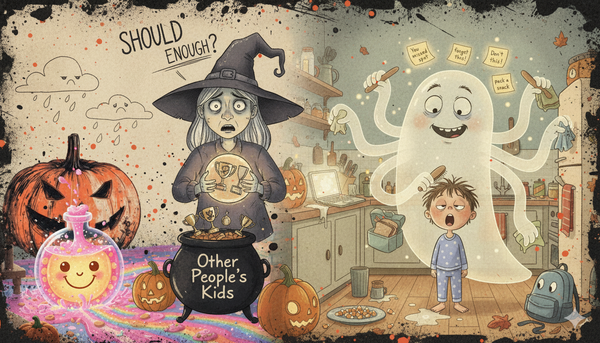


Member discussion